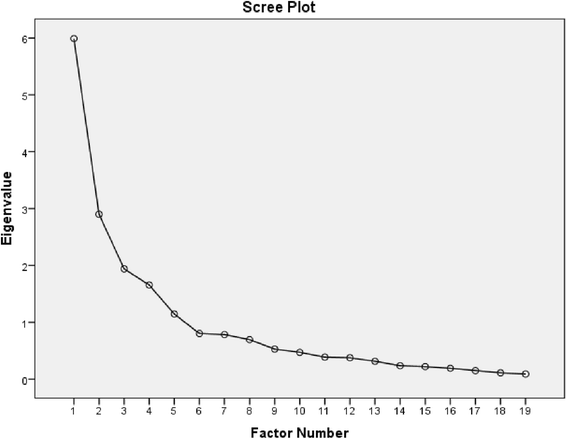The preventive services use self-efficacy (PRESS) scale in older women: development and psychometric properties
- PMID: 26897364
- PMCID: PMC4761175
- DOI: 10.1186/s12913-016-1321-x
The preventive services use self-efficacy (PRESS) scale in older women: development and psychometric properties
Abstract
Background: Preventive services offered to older Americans are currently under-utilized despite considerable evidence regarding their health and economic benefits. Individuals with low self-efficacy in accessing these services need to be identified and provided self-efficacy enhancing interventions. Scales measuring self-efficacy in the management of chronic diseases exist, but do not cover the broad spectrum of preventive services and behaviors that can improve the health of older adults, particularly older women who are vulnerable to poorer health and lesser utilization of preventive services. This study aimed to evaluate the psychometric properties of a new preventive services use self-efficacy scale, by measuring its internal consistency reliability, assessing internal construct validity by exploring factor structure, and examining differences in self-efficacy scores according to participant characteristics.
Methods: The Preventive Services Use Self-Efficacy (PRESS) Scale was developed by an expert panel at the University of Pittsburgh Center for Aging and Population Health - Prevention Research Center. It was administered to 242 women participating in an ongoing trial and the data were analyzed to assess its psychometric properties. An exploratory factor analysis with a principal axis factoring approach and orthogonal varimax rotation was used to explore the underlying structure of the items in the scale. The internal consistency of the subscales was assessed using Cronbach's alpha coefficient.
Results: The exploratory factor analysis defined five self-efficacy factors (self-efficacy for exercise, communication with physicians, self-management of chronic disease, obtaining screening tests, and getting vaccinations regularly) formed by 16 items from the scale. The internal consistency of the subscales ranged from .81 to .94. Participants who accessed a preventive service had higher self-efficacy scores in the corresponding sub-scale than those who did not.
Conclusions: The 16-item PRESS scale demonstrates preliminary validity and reliability in measuring self-efficacy in the use of preventive services among older women. It can potentially be used to evaluate the impact of interventions designed to improve self-efficacy in the use of preventive services in community-dwelling older women.
Figures
Similar articles
-
Psychometric properties of the Korean version of the Pulmonary Rehabilitation Adapted Index of Self-Efficacy (PRAISE) for individuals with COPD.Int J Chron Obstruct Pulmon Dis. 2017 Aug 29;12:2611-2620. doi: 10.2147/COPD.S142488. eCollection 2017. Int J Chron Obstruct Pulmon Dis. 2017. PMID: 28919729 Free PMC article.
-
Development and psychometric testing of the relocation self-efficacy scale.Nurs Res. 2007 Jul-Aug;56(4):244-51. doi: 10.1097/01.NNR.0000280609.16244.de. Nurs Res. 2007. PMID: 17625463
-
The Yoruba version of the Beck Hopelessness Scale: psychometric characteristics and correlates of hopelessness in a sample of Nigerian psychiatric outpatients.Compr Psychiatry. 2015 Jan;56:258-71. doi: 10.1016/j.comppsych.2014.09.024. Epub 2014 Oct 2. Compr Psychiatry. 2015. PMID: 25446724
-
Development of health belief in emerging infectious respiratory disease preventive behaviors' scale.Nurs Health Sci. 2022 Jun;24(2):508-518. doi: 10.1111/nhs.12948. Epub 2022 May 24. Nurs Health Sci. 2022. PMID: 35510531 Review.
-
Measurements of self-efficacy in musculoskeletal rehabilitation: A systematic review.Musculoskeletal Care. 2018 Dec;16(4):471-488. doi: 10.1002/msc.1362. Epub 2018 Sep 20. Musculoskeletal Care. 2018. PMID: 30238607 Free PMC article.
Cited by
-
A cross-sectional study of the preventive health care activities of western Canadian rural-living patients unattached to primary care providers.Prev Med Rep. 2022 Jul 21;29:101913. doi: 10.1016/j.pmedr.2022.101913. eCollection 2022 Oct. Prev Med Rep. 2022. PMID: 35879934 Free PMC article.
-
Efficacy of Emotion Regulation for Patients Suffering from Chronic Obstructive Pulmonary Disease.Iran J Public Health. 2017 Jan;46(1):50-54. Iran J Public Health. 2017. PMID: 28451529 Free PMC article.
-
COVID-19 Vaccine Hesitancy: Disadvantaged Groups' Experience with Perceived Barriers, Cues to Action, and Attitudes.Am J Health Promot. 2023 May;37(4):488-498. doi: 10.1177/08901171221136113. Epub 2022 Oct 28. Am J Health Promot. 2023. PMID: 36306535 Free PMC article.
-
Health concerns among waste collectors during pandemic crisis.Environ Sci Pollut Res Int. 2022 Jan;29(5):6463-6478. doi: 10.1007/s11356-021-16071-y. Epub 2021 Aug 27. Environ Sci Pollut Res Int. 2022. PMID: 34453243 Free PMC article.
-
Generating user-driven patient personas to support preventive health care activities of rural-living unattached patients.PEC Innov. 2024 Mar 13;4:100274. doi: 10.1016/j.pecinn.2024.100274. eCollection 2024 Dec. PEC Innov. 2024. PMID: 38550352 Free PMC article.
References
-
- Centers for Disease Control and Prevention AoA, Agency for Healthcare Research and Quality, and, Services CfMaM. Enhancing Use of Clinical Preventive Services Among Older Adults. 2011.
Publication types
MeSH terms
Grants and funding
LinkOut - more resources
Full Text Sources
Other Literature Sources
Medical


